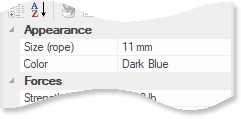
This also applies to cable, chain, and webbing.
Gear that is anchored includes anchors, rocks, trees, tripods, trucks, etc.
A "bight" is a simple loop in a rope that does not cross itself.
A "bend" is a knot that joins two ropes together. Bends can only be attached to the end of a rope.
A "hitch" is a type of knot that must be tied around another object.
"Descending devices" (e.g., ATCs, Brake Bar Racks, Figure 8s, Rescue 8s, etc) create friction as their primary purpose. The friction in descending devices is always considered when calculating forces.
The "Safety Factor" is the ratio between the gear's breaking strength and the maximum load applied to the gear (e.g., 5:1).
You can change the size of gear by entering a percentage in the Appearance section in the properties pane. That is true for ropes, too. However, if only ropes, webbing, or hoses are selected, you can also enter the size in millimeters, centimeters, or inches.
When one of these items is selected, the properties pane will show the name of the gear in parentheses after the word Size in the properties pane. That's a reminder to you that you can enter the item's size using these measurement units.

For example, you could enter '8 mm', '2.5 cm', '3 in', '3.5"', or '150%'. The acceptable values depend on the selected item (e.g., 8 mm hoses and 3' ropes aren't reasonable).
If you do not specify the measurement units, the currently displayed units will be used. For example, if you enter '8' in the above properties pane, the size will be set to 8 mm.
If you select multiple items which include ropes, webbing, or hoses, a percent sign will be shown after the word Size in the properties pane to remind you that you are entering a percentage.

The size setting only affects a rope's appearance and does not affect the Force Calculations. Change the strength in the properties pane to change a rope's breaking strength.